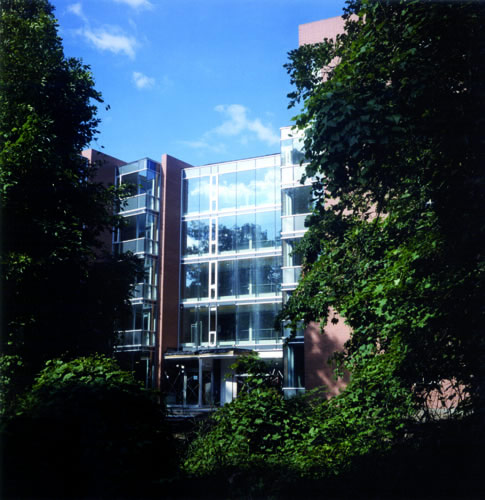The cramped quarters, lacklustre furnishings and communal washrooms often associated with university dorms are conspicuously absent in the University of Toronto at Mississauga (UTM) residence that opened in September.
Erindale Hall offers accommodation that anyone would be proud to call home. The residence is organized around suites that contain four single bedrooms, two bathrooms and a common room with a kitchen. Every suite in the $16-million facility has custom-designed bedroom furniture, a fridge and stove, a security-controlled entry, air conditioning and hard-wired Internet access.
UTM is one of the only campuses in Canada to guarantee a single room for every first-year student, says Chris McGrath, the residence director. The new 197-bed residence brings the number of undergraduate beds at UTM to almost 800.
Designed by Baird Sampson Neuert Architects Inc. of Toronto, Erindale Hall qualified for a federal government incentive program that provides up to $60,000 for buildings that minimize energy consumption and lower greenhouse emissions. High-efficiency boilers, a heat-recovery system for exhaust air and specially insulated outer walls are among the energy-efficient features. The design takes an aggressive approach to reducing the building’s overall environmental footprint, says Jon Neuert (BArch 1990), one of the principal architects on the project.
The building also treads lightly on the sensitive ecological zone that surrounds it, preserving the wooded areas on the east and west sides of the building that serve as a refuge for native wildlife. Large windows throughout the residence bring the outside in, says Neuert. “The forest landscape becomes a seasonally changing panorama that’s part of the experience of the interior of the building.” Canadian Architect magazine recognized the design with a 2002 Award of Excellence.
McGrath says Erindale Hall’s amenities attracted new students and gave UTM an edge in recruitment, but the new residence and larger number of students living on campus have forced him to redesign residence programming. “It’s more challenging to build a community when students are huddled into these smaller pods,” he says. This autumn, McGrath responded to the challenge by launching a pilot initiative called Living Learning Communities, which gives students the option of living with peers who share common interests – whether it be the performing arts or international development.
Recent Posts
U of T’s Feminist Sports Club Is Here to Bend the Rules
The group invites non-athletes to try their hand at games like dodgeball and basketball in a fun – and distinctly supportive – atmosphere
From Mental Health Studies to Michelin Guide
U of T Scarborough alum Ambica Jain’s unexpected path to restaurant success
A Blueprint for Global Prosperity
Researchers across U of T are banding together to help the United Nations meet its 17 sustainable development goals






